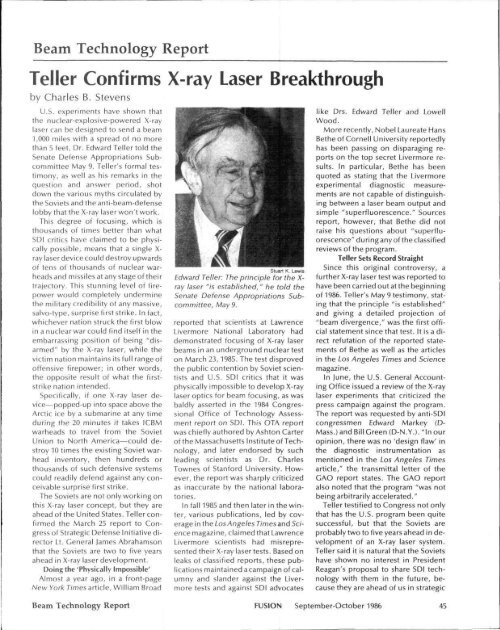You also want an ePaper? Increase the reach of your titles
YUMPU automatically turns print PDFs into web optimized ePapers that Google loves.
Beam Technology Report<br />
Teller Confirms X-ray Laser Breakthrough<br />
by Charles B. Stevens<br />
U.S. experiments have shown that<br />
the nuclear-explosive-powered X-ray<br />
laser can be designed to send a beam<br />
1,000 miles with a spread <strong>of</strong> no more<br />
than 5 feet, Dr. Edward Teller told the<br />
Senate Defense Appropriations Subcommittee<br />
May 9. Teller's formal testimony,<br />
as well as his remarks in the<br />
question and answer period, shot<br />
down the various myths circulated by<br />
the Soviets and the anti-beam-defense<br />
lobby that the X-ray laser won't work.<br />
This degree <strong>of</strong> focusing, which is<br />
thousands <strong>of</strong> times better than what<br />
SDI critics have claimed to be physically<br />
possible, means that a single Xray<br />
laser device could destroy upwards<br />
<strong>of</strong> tens <strong>of</strong> thousands <strong>of</strong> nuclear warheads<br />
and missiles at any stage <strong>of</strong> their<br />
trajectory. This stunning level <strong>of</strong> firepower<br />
would completely undermine<br />
the military credibility <strong>of</strong> any massive,<br />
salvo-type, surprise first strike. In fact,<br />
whichever nation struck the first blow<br />
in a nuclear war could find itself in the<br />
embarrassing position <strong>of</strong> being "disarmed"<br />
by the X-ray laser, while the<br />
victim nation maintains its full range <strong>of</strong><br />
<strong>of</strong>fensive firepower; in other words,<br />
the opposite result <strong>of</strong> what the firststrike<br />
nation intended.<br />
Specifically, if one X-ray laser device—popped-up<br />
into space above the<br />
Arctic ice by a submarine at any time<br />
during the 20 minutes it takes ICBM<br />
warheads to travel from the Soviet<br />
Union to North America—could destroy<br />
10 times the existing Soviet warhead<br />
inventory, then hundreds or<br />
thousands <strong>of</strong> such defensive systems<br />
could readily defend against any conceivable<br />
surprise first strike.<br />
<strong>The</strong> Soviets are not only working on<br />
this X-ray laser concept, but they are<br />
ahead <strong>of</strong> the United States. Teller confirmed<br />
the March 25 report to Congress<br />
<strong>of</strong> Strategic Defense Initiative director<br />
Lt. General James Abrahamson<br />
that the Soviets are two to five years<br />
ahead in X-ray laser development.<br />
Doing the 'Physically Impossible'<br />
Almost a year ago, in a front-page<br />
New York Times article, William Broad<br />
Stuart K. Lawis<br />
Edward Teller: <strong>The</strong> principle for the Xray<br />
laser "is established," he told the<br />
Senate Defense Appropriations Subcommittee,<br />
May 9.<br />
reported that scientists at Lawrence<br />
Livermore National Laboratory had<br />
demonstrated focusing <strong>of</strong> X-ray laser<br />
beams in an underground nuclear test<br />
on March 23,1985. <strong>The</strong> test disproved<br />
the public contention by Soviet scientists<br />
and U.S. SDI critics that it was<br />
physically impossible to develop X-ray<br />
laser optics for beam focusing, as was<br />
baldly asserted in the 1984 Congressional<br />
Office <strong>of</strong> Technology Assessment<br />
report on SDI. This OTA report<br />
was chiefly authored by Ashton Carter<br />
<strong>of</strong> the Massachusetts Institute <strong>of</strong> Technology,<br />
and later endorsed by such<br />
leading scientists as Dr. Charles<br />
Townes <strong>of</strong> Stanford University. However,<br />
the report was sharply criticized<br />
as inaccurate by the national laboratories.<br />
In fall 1985 and then later in the winter,<br />
various publications, led by coverage<br />
in the Los Angeles Times and Science<br />
magazine, claimed that Lawrence<br />
Livermore scientists had misrepresented<br />
their X-ray laser tests. Based on<br />
leaks <strong>of</strong> classified reports, these publications<br />
maintained a campaign <strong>of</strong> calumny<br />
and slander against the Livermore<br />
tests and against SDI advocates<br />
like Drs. Edward Teller and Lowell<br />
Wood.<br />
More recently, Nobel Laureate Hans<br />
Bethe <strong>of</strong> Cornell University reportedly<br />
has been passing on disparaging reports<br />
on the top secret Livermore results.<br />
In particular, Bethe has been<br />
quoted as stating that the Livermore<br />
experimental diagnostic measurements<br />
are not capable <strong>of</strong> distinguishing<br />
between a laser beam output and<br />
simple "superfluorescence." Sources<br />
report, however, that Bethe did not<br />
raise his questions about "superfluorescence"<br />
during any <strong>of</strong> the classified<br />
reviews <strong>of</strong> the program.<br />
Teller Sets Record Straight<br />
Since this original controversy, a<br />
further X-ray laser test was reported to<br />
have been carried out at the beginning<br />
<strong>of</strong> 1986. Teller's May 9 testimony, stating<br />
that the principle "is established"<br />
and giving a detailed projection <strong>of</strong><br />
"beam divergence," was the first <strong>of</strong>ficial<br />
statement since that test. It is a direct<br />
refutation <strong>of</strong> the reported statements<br />
<strong>of</strong> Bethe as well as the articles<br />
in the Los Angeles Times and Science<br />
magazine.<br />
In June, the U.S. General Accounting<br />
Office issued a review <strong>of</strong> the X-ray<br />
laser experiments that criticized the<br />
press campaign against the program.<br />
<strong>The</strong> report was requested by anti-SDI<br />
congressmen Edward Markey (D-<br />
Mass.) and Bill Green (D-N.Y.). "In our<br />
opinion, there was no 'design flaw' in<br />
the diagnostic instrumentation as<br />
mentioned in the Los Angeles Times<br />
article," the transmittal letter <strong>of</strong> the<br />
GAO report states. <strong>The</strong> GAO report<br />
also noted that the program "was not<br />
being arbitrarily accelerated."<br />
Teller testified to Congress not only<br />
that has the U.S. program been quite<br />
successful, but that the Soviets are<br />
probably two to five years ahead in development<br />
<strong>of</strong> an X-ray laser system.<br />
Teller said it is natural that the Soviets<br />
have shown no interest in President<br />
Reagan's proposal to share SDI technology<br />
with them in the future, because<br />
they are ahead <strong>of</strong> us in strategic<br />
Beam Technology Report FUSION September-October 1986 45

















